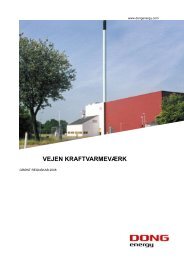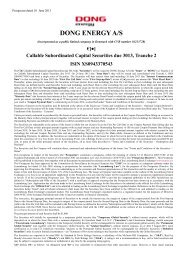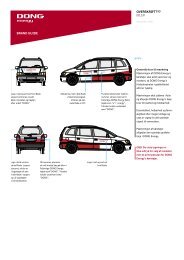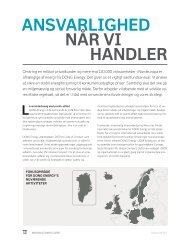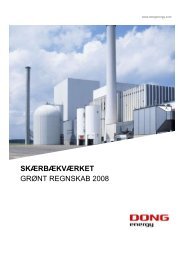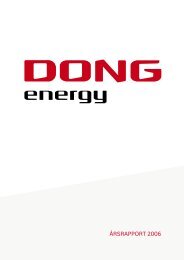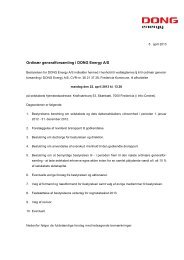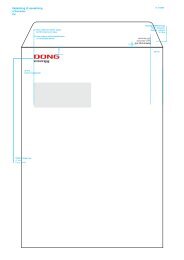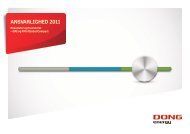ANNUAL REPORT 2011 - DONG Energy
ANNUAL REPORT 2011 - DONG Energy
ANNUAL REPORT 2011 - DONG Energy
Create successful ePaper yourself
Turn your PDF publications into a flip-book with our unique Google optimized e-Paper software.
notes<br />
40 Description of accounting policies<br />
Other inventories are measured at cost using the first-in, firstout<br />
(FIFO) principle or net realisable value. Inventories are<br />
written down to net realisable value whenever the cost exceeds<br />
the net realisable value.<br />
The net realisable value of inventories is determined as the<br />
expected selling price less any costs of completion and costs<br />
incurred to execute the sale, and is determined taking into<br />
account marketability, obsolescence and development of expected<br />
selling price.<br />
receivables<br />
Receivables are measured at amortised cost. A write-down<br />
for bad and doubtful debts is made if there is any objective<br />
evidence of impairment of a receivable or a portfolio of<br />
receivables.<br />
Receivables for which objective evidence of impairment is not<br />
available on an individual basis are assessed for impairment on<br />
a portfolio basis. Portfolios are primarily based on the debtor’s<br />
registered office and credit rating in conformity with the<br />
Group’s credit risk management policy. The objective evidence<br />
applied to portfolios is determined on the basis of historical<br />
loss experience.<br />
If there is any objective evidence of impairment of a portfolio,<br />
an impairment test is carried out where expected future cash<br />
flows are estimated on the basis of historical loss experience<br />
adjusted for current market conditions and individual factors<br />
related to the individual portfolio.<br />
The impairment loss is calculated as the difference between<br />
the carrying amount and the present value of estimated future<br />
cash flows, including the realisable value of any collateral received.<br />
The discount rate used is the effective interest rate for<br />
the individual receivable or portfolio.<br />
Recognition of interest income on impaired receivables is calculated<br />
on the written-down value at the effective interest rate<br />
for the individual receivable or portfolio.<br />
Construction contracts<br />
Construction contracts comprise the construction of assets<br />
involving a high degree of customisation in terms of design,<br />
and where a binding contract has been entered into prior to<br />
start-up of the work that will trigger a penalty or compensation<br />
in the event of subsequent cancellation. Construction<br />
contracts also include services such as establishment of grids<br />
and networks, etc. Construction contracts are measured at the<br />
selling price of the work performed less progress billings. The<br />
selling price of construction contracts is measured on the basis<br />
of the stage of completion at the balance sheet date and total<br />
138 COnsOliDatED finanCial statEmEnts – <strong>DONG</strong> ENERGY <strong>ANNUAL</strong> <strong>REPORT</strong> <strong>2011</strong><br />
expected income on each contract. The stage of completion<br />
is determined on the basis of an assessment of the work performed,<br />
normally determined as the proportion that contract<br />
costs incurred for work performed to date bear to the estimated<br />
total contract costs.<br />
When it is probable that total contract costs on a construction<br />
contract will exceed total contract revenue, the expected loss<br />
on the construction contract is recognised immediately as an<br />
expense and a provision.<br />
When the outcome of a construction contract cannot be estimated<br />
reliably, the selling price is recognised only to the extent<br />
of costs incurred that it is probable will be recoverable.<br />
Where the selling price of work performed on construction contracts<br />
exceeds progress billings and expected losses, the contracts<br />
are recognised as receivables. Where progress billings<br />
and expected losses exceed the selling price of construction<br />
contracts, the contracts are recognised as liabilities.<br />
Prepayments from customers are recognised as liabilities.<br />
Costs related to sales work and the winning of contracts are<br />
recognised in profit for the year as incurred.<br />
short-term and long-term securities<br />
Securities, comprising bonds that are monitored, measured<br />
and reported at fair value on a continuing basis in conformity<br />
with the Group’s investment policy, are recognised at the trade<br />
date as current assets and measured at fair value, equivalent<br />
to market price for listed securities and estimated fair value<br />
determined on the basis of current market data and recognised<br />
valuation methods for unlisted securities.<br />
Changes in the fair value of securities are recognised in profit<br />
for the year as finance income and costs.<br />
Sold securities where a repurchase agreement (repo transactions)<br />
has been made at the time of sale are recognised in the<br />
balance sheet at the settlement date as if the securities were<br />
still held. The amount received is recognised as a liability, and<br />
the difference between the selling price and the purchase price<br />
is recognised in profit for the year over the term as interest. The<br />
return on the securities is recognised in profit for the year.<br />
income tax and deferred tax<br />
Current tax payable and receivable is recognised in the balance<br />
sheet as tax computed on the taxable income for the year, adjusted<br />
for taxes paid on account.



